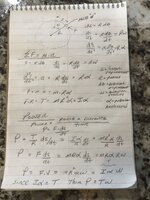From Newtonian physics, F = ma, the net force of a system will contribute to its acceleration, and in a case of no friction or such energy losses, theoretically all forces will contribute to acceleration in that sense.
In the context of machine elements, if we ignore friction and everything... all torques added to a gear will contribute to its acceleration, described by the formula T = I*angular_acceleration
From what I understand, the relation between power, force and speed is: P = F*v
The dimensions make sense, but I've seen this formula used in such a way:
Pmotor = Fmotor * v
And I don't now how to connect this to the acceleration concept.
If Fmotor contributes to acceleration, why does P = F*v even exist, it relates the force and speed directly, but if I waited a little longer while keeping that same force the speed will increase correct?
Or maybe this formula is the force it takes to maintain the speed v, which makes sense, and so it would be equal to the friction and other forces of loss correct? Is that what it is?
If that's what it:
Does that mean it doesn't apply for ideal scenarios without friction and resistance?
Why does the power P or v even matter in such a case, wouldn't a formula such as Fmotor = F_friction be better? Cause the speed wouldn't matter in such a case since as long as Fmotor = Ffriction it will always be maintained, so I don't get why P = F * v is even used.
Perhaps I don't understand the concept or what this formula describes. Any explanation is appreciated, thank you for your time.
In the context of machine elements, if we ignore friction and everything... all torques added to a gear will contribute to its acceleration, described by the formula T = I*angular_acceleration
From what I understand, the relation between power, force and speed is: P = F*v
The dimensions make sense, but I've seen this formula used in such a way:
Pmotor = Fmotor * v
And I don't now how to connect this to the acceleration concept.
If Fmotor contributes to acceleration, why does P = F*v even exist, it relates the force and speed directly, but if I waited a little longer while keeping that same force the speed will increase correct?
Or maybe this formula is the force it takes to maintain the speed v, which makes sense, and so it would be equal to the friction and other forces of loss correct? Is that what it is?
If that's what it:
Does that mean it doesn't apply for ideal scenarios without friction and resistance?
Why does the power P or v even matter in such a case, wouldn't a formula such as Fmotor = F_friction be better? Cause the speed wouldn't matter in such a case since as long as Fmotor = Ffriction it will always be maintained, so I don't get why P = F * v is even used.
Perhaps I don't understand the concept or what this formula describes. Any explanation is appreciated, thank you for your time.


